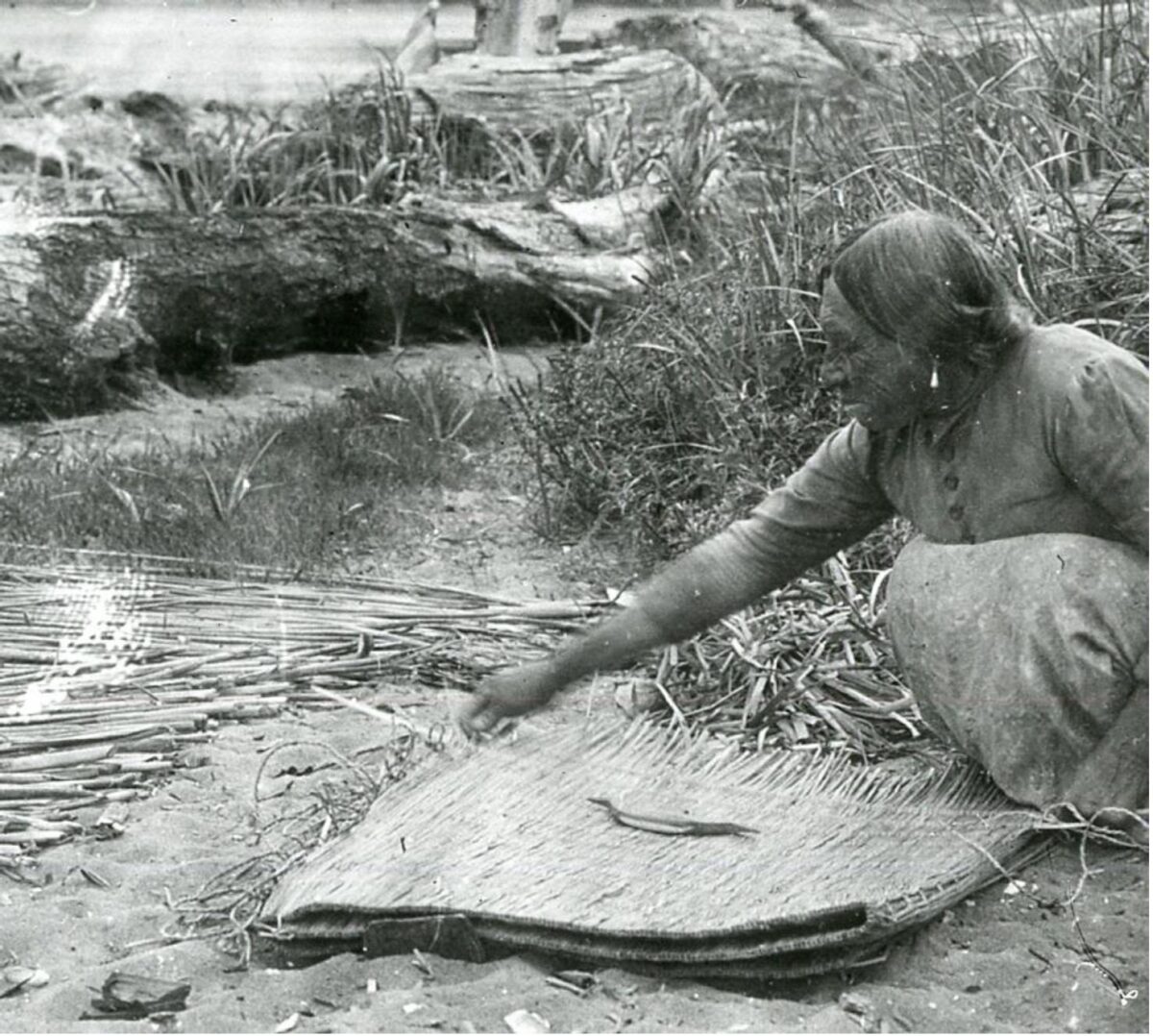By Grant Keddie. April 10, 2023.
Introduction
Cattail (Typha latifolia) mats were one of the most prolific artifacts found in traditional cultures in coastal areas of southern British Columbia and northwestern Washington State. They were used to construct the walls and roofs of temporary shelters at fishing camps, for insulating walls in winter houses, as covers to protect canoes and their contents, for light baskets, for bedding, sitting on and as mats for storing food and preparing food on. What are called mat creasers were important tools used in the production of a number of these cultural items.

A mat creaser was an important tool that, used in conjunction with a needle, crimped the split cattail reeds in order to prevent them from splitting further and to provide more room to pull a string through to tie the leaves closely together. The age, distribution and iconography of these important artifacts has been a subject of limited research.
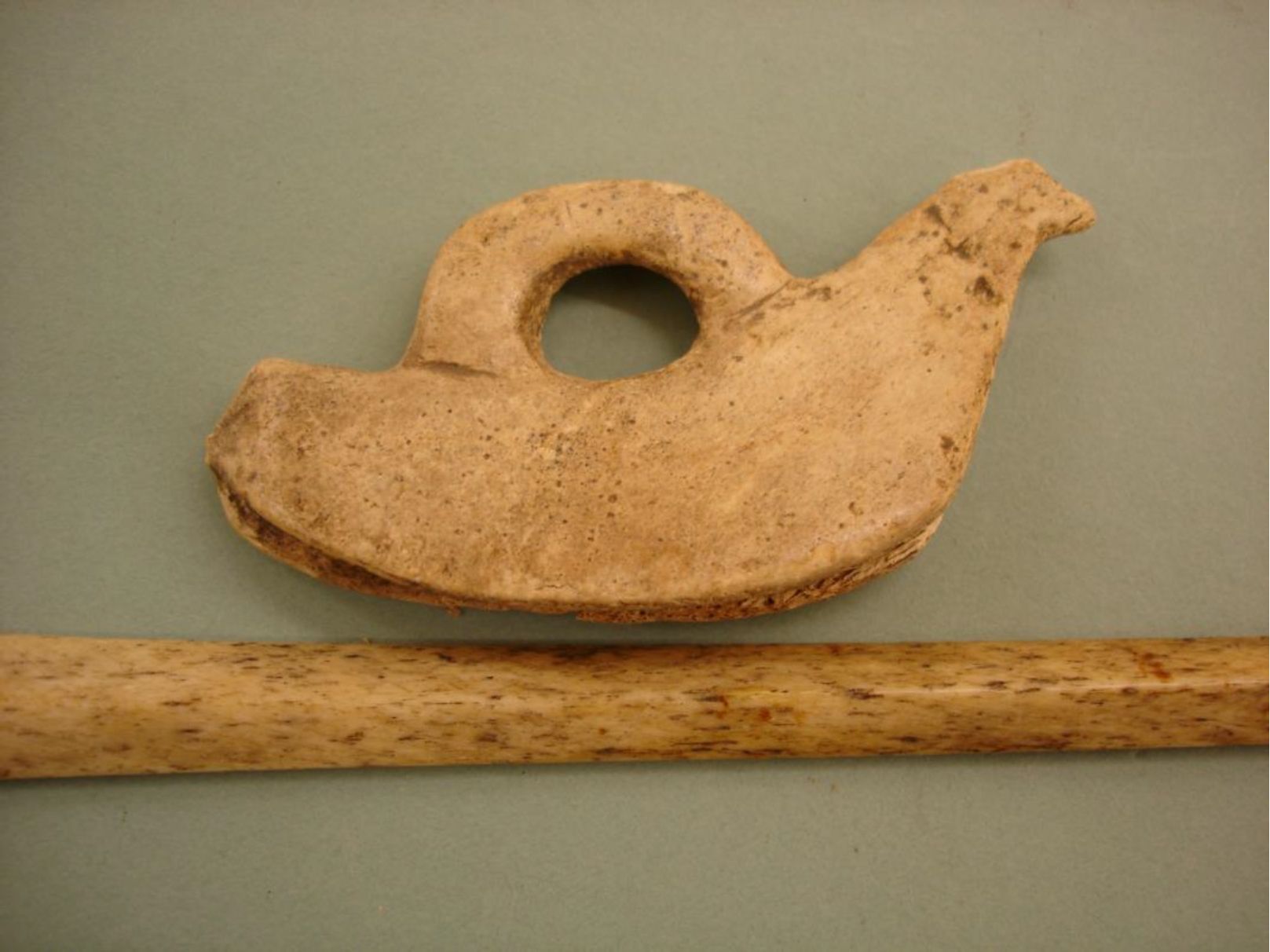


In my own experiments when collecting and processing cattail reeds, there was one important observation. When the flat needle is put through the row of cattail leaves, it is then turned so the thin edge is upward – increasing the inner space by pulling the sides of the reed apart. The wide V-shaped groove of the creaser is then run along this thin edge of the needle to crimp the upper portion of the reed. This prevents the leaves from spitting further than the original split made when the needle was pushed through the leaf. The crimping is not done after the needle is pulled out as has been incorrectly stated in some publications. After creasing the cattail, the needle was pulled through with attached twisted strands of string made from cattail edges or stinging nettle.
Mats were also made of other round stem reeds such as Schoenoplectus acutus that comes under several common names, but the focus here is the Cattail (Typha latifolia) of the Cattail family. The latter were gathered in large quantities, mostly by women, among speakers of Salish languages around the Salish Sea and among the Chinook of the Columbia River. They formed an important trade item with the Nuu-chah-nulth people on the west coast of Vancouver Island and the western Olympic Peninsula. The Makah obtained them from the Klallam (Lane 1972:16). However, the mat creasers are a cultural artifact found among the several Nuu-chah-nuth populations. Four of the five long matting needles in the RBCM collection are from Ahousaht on the west coast of Vancouver Island.
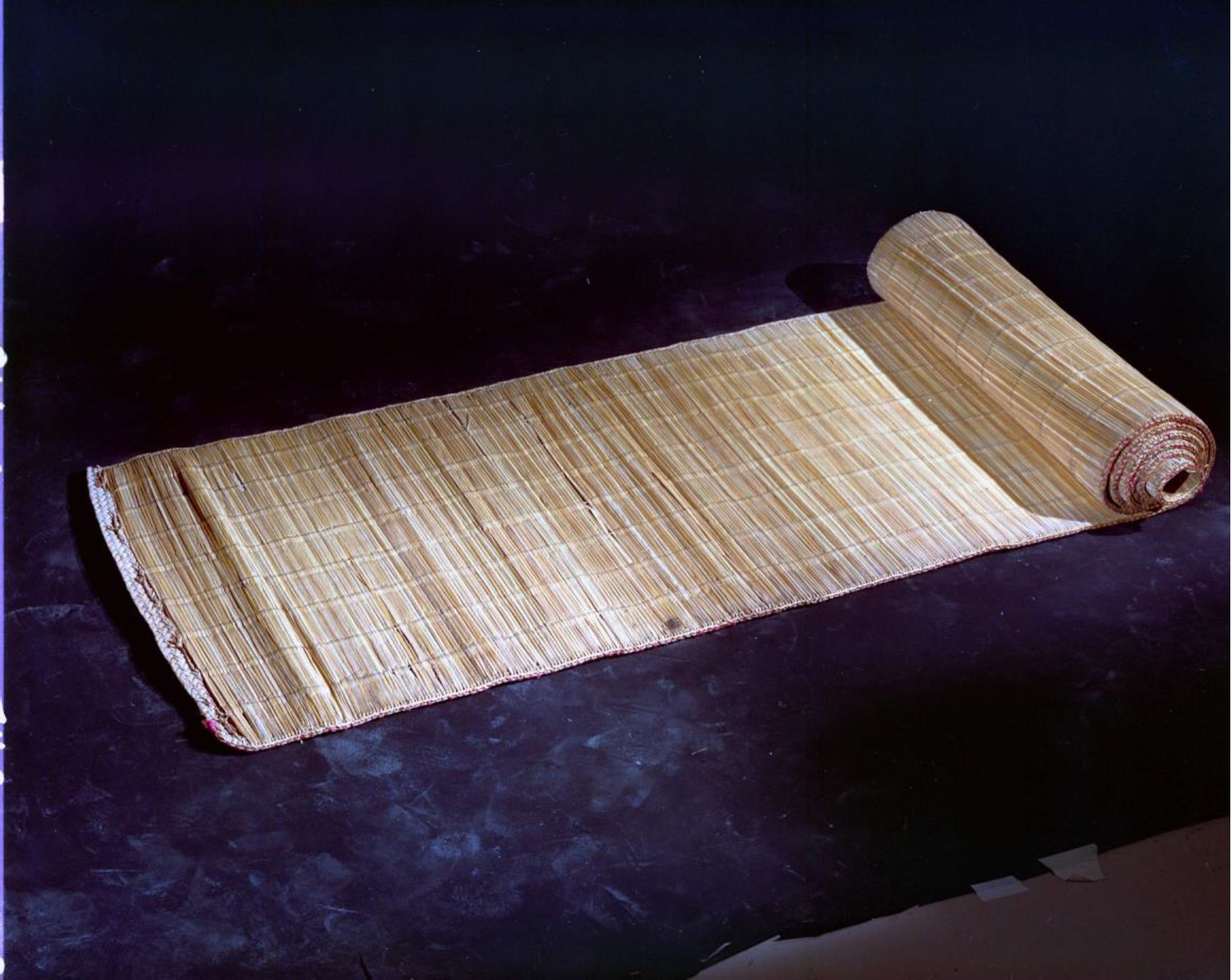
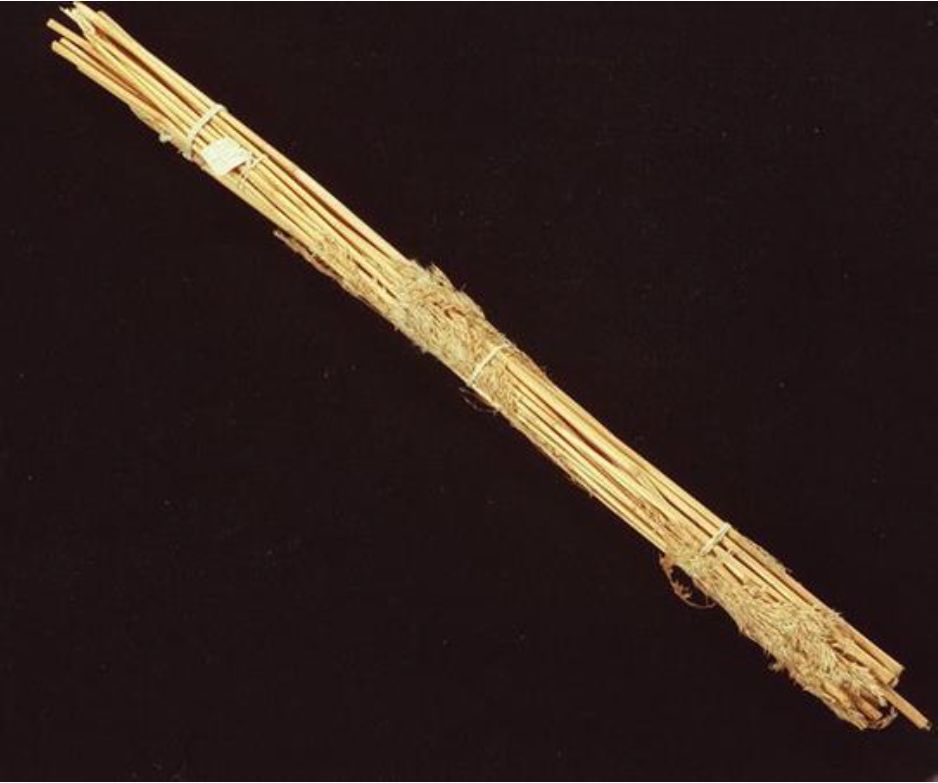

Here I will provide an overview description of the creasers from British Columbia and Washington state that are found in the Royal B.C. Museum and other museums around the world. The artifact claimed to be a 3000-year-old creaser from the Hoko River site on the Olympic Peninsula is, from my experiments, not a creaser (see Appendix 1).
The Indigenous Collections of the RBCM
There are 33 mat creasers in the RBCM historic Indigenous (ethnology) collection. Twenty-four are ascribed to be from Salish language family speakers. These include 14 recorded as Island Halkomelem; two from mainland Halkomelem; three from unknown locations and one north Straits Salish. Eight creasers are Nuu-chan-nulth and only one is recorded as Kwakwaka’wakw. One made as an art piece is not included here. There are only three creasers in the RBCM archaeology collections. I will deal here with the archaeological artifacts and then the more numerous historic examples. This will follow with some documented examples of the harvest of reeds and the use of the mat creasers.
Since we are dealing with old museum collections there are some problems identifying more precise locations where some creasers came from. This is partly because of changing name uses. It was common in the 19th and early 20th century to refer to all the people that spoke one of the languages of the Salish language family as “Cowichan”, which should have only applied to the various indigenous populations living in the general region near Duncan on Vancouver Island. Many of these creasers were purchased from Indigenous people who were not the ones that used them or were no longer using them. Some were acquired by private collectors who, at the time, did not interview Indigenous people to find out more information on the use and history of the creasers.
In examining the historic and ethnographic accounts about when and how raw materials were collected and the details of how mats were made it is important to be aware of the different climatic zones and potentially different regional practices. Although many peoples baked the roots and inner stocks to eat, they did not all have easy access to cattail resources. Anthropologist Erna Gunther indicates that the Makah of Neah Bay stated that “cat-tails have always been very scarce, and their gathering necessitates some travel from their villages. …the Quinault also must travel for cat-tails going to Grays Harbour to get them in quantity” (Gunther 1945).
We are fortunate in having several mid to late 19th century observations of reed production. I will also reveal what I have learned from my own experimentation. It needs to be kept in mind that all of the museum ethnographic examples were carved with iron or steel files and knives and would likely have an influence on how they may have looked different from any earlier ones that were not made with these tools. Iron was commonly available by at least 1795 (Keddie 2006).
One of problems with the early literature is sometimes the uncertainty as to which reed plant is being written about. Cattails as well as other plants were referred to as “bullrushes” and some of the earlier Latin names underwent name changes. (see Turner 1998 for uses of other plants that are often named under the title of “reeds”).
The Archaeology of Mat Creasers
Archaeological examples of mat creasers are rare. There are only three in the collection of the Royal B.C. Museum. Two of these are made of stone and one of antler. All of these were found eroding out of old village sites with extensive shellmidden features and not found during scientific excavations of archaeological sites. Therefore, they are not dated, and we can only guess that they are, at least, 300 years old.
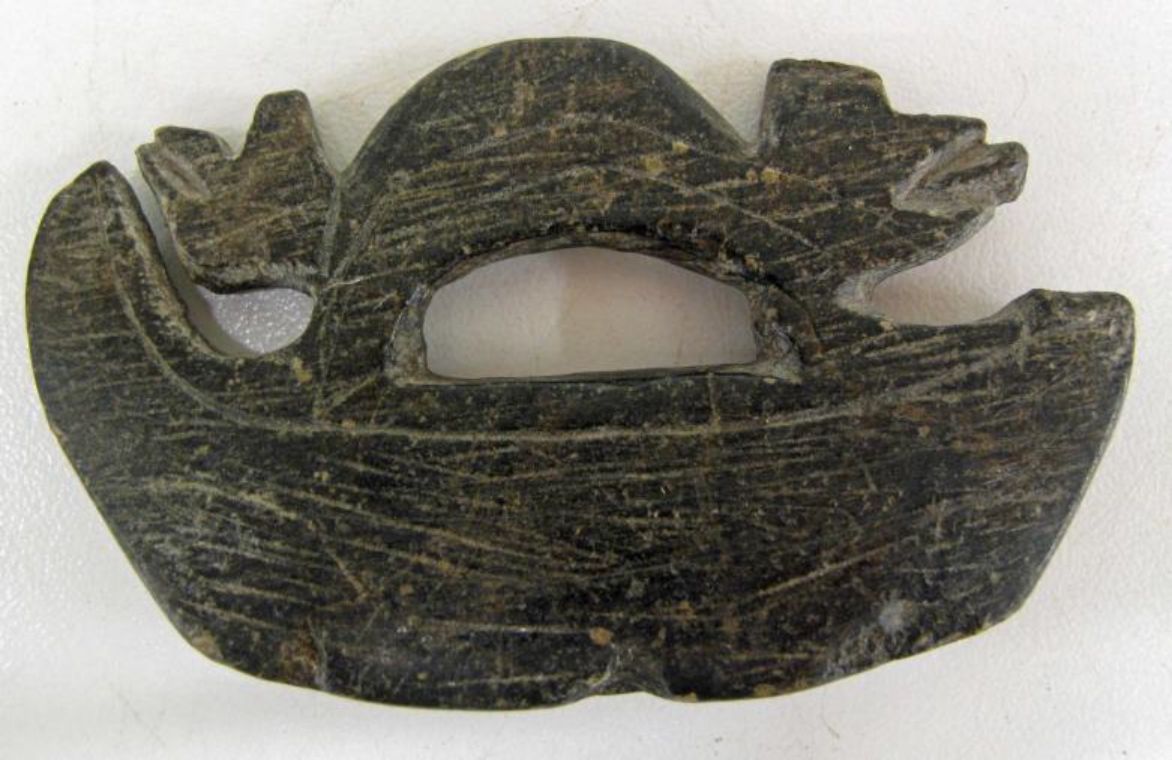
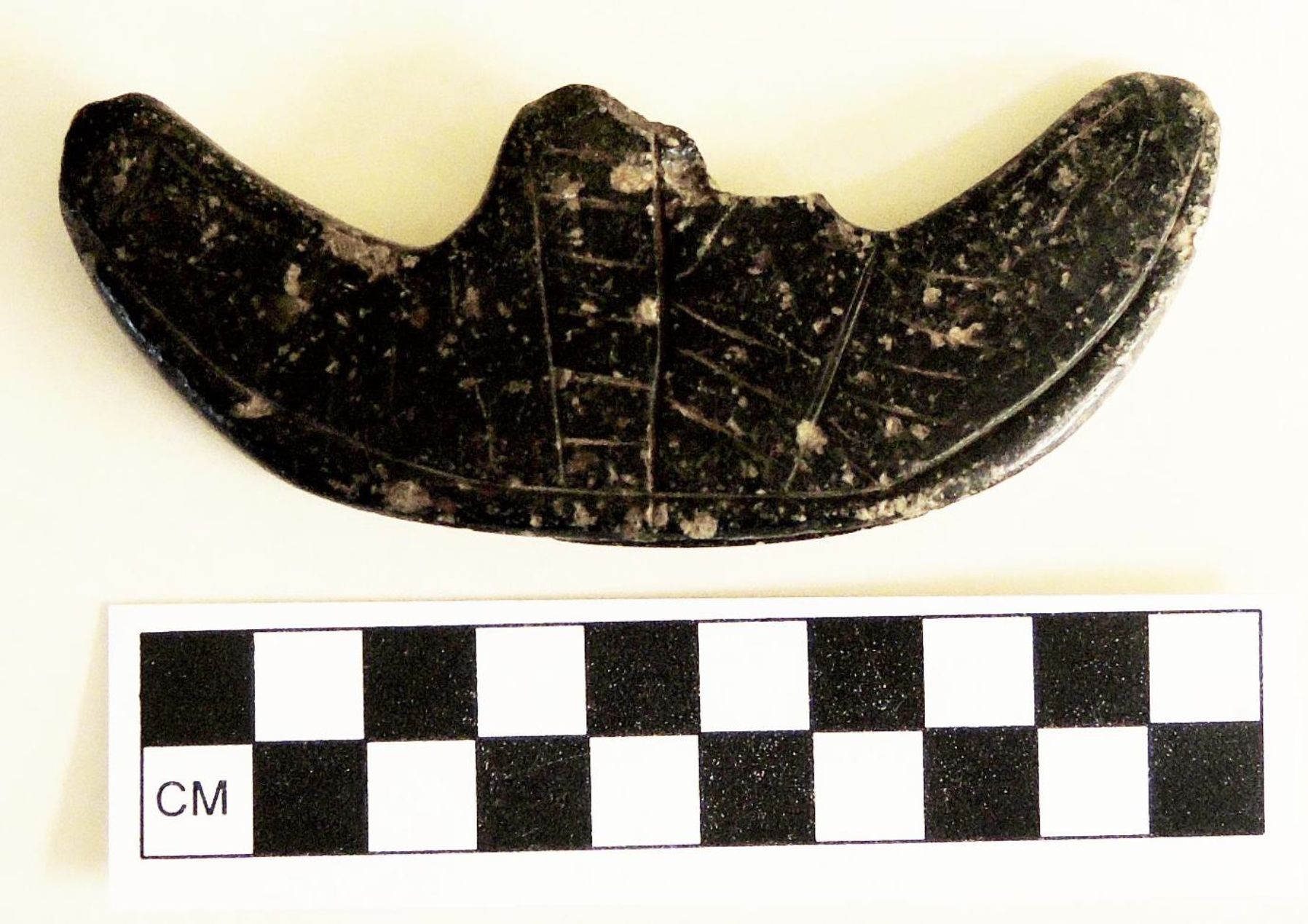
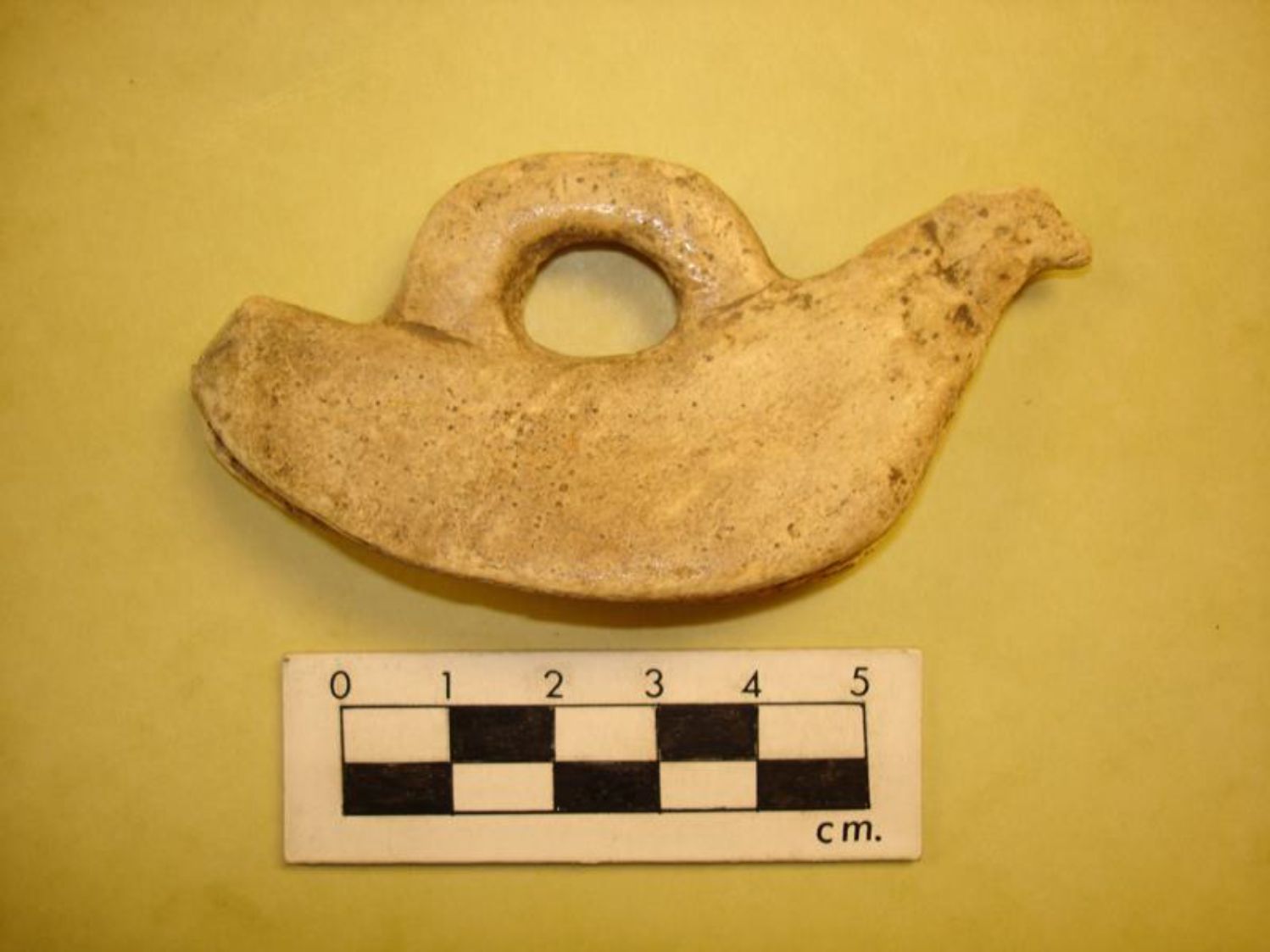
The Museum Historic Mat Creasers
Designs
Most mat creasers in museum collections are made of wood, and are ethnological specimens collected in the early to mid-20th century. The most common designs of creasers are birds and what I consider as double headed lightning snake or Sisuitl creatures. The latter go under different names such as Sinulky and are like snakes but can have head plums, wings and two or four legs. They have supernatural powers and often live in swamps or lakes.
The heads of the latter creature are often vaguely outlined on the mat creasers and mistaken as mammals when shown with square snouts (figure 13). One or more of the heads are often broken off but continued to be used – as exhibited by the worn-over broken areas. There are enough examples with detailed carvings to show that the vague stylistic bodies are the various representations of the supernatural lightning snake creatures (Keddie 2023). The double headed lightning creatures have a middle body that sometimes resembles a boat but is also the body of the lightning snakes. Lightning snakes, by tradition, could transform themselves into canoes. In the middle, between the creature heads that extend to the sides, is often a square box-like upward protrusion. One of these (figure 15) resembles a sail and a sail like etching can be seen on the stone archaeological artifact (figure 9).

The birds can usually be identified as varieties of ducks or mergansers (figure12). One example from the west coast of Vancouver Island (figure 18) may represent a winged lightning snake and another, missing its original side heads has an engraved bird with wing feathers pencilled in below (Figure 18). The positioning of this figure is similar to how Thunderbirds are often represented. Lightning snakes are well known as the weapons of the Thunderbird. A few examples are four-legged creatures that may represent lizards (figure 20), but some mythical lightning snakes also have four legs. One older mat creaser represents an otter (figure 20). Otters are linked to shamanistic practices, but their symbolism, like the ducks, may be related to the fact that they live in the same places where people gather cattails for making mats.
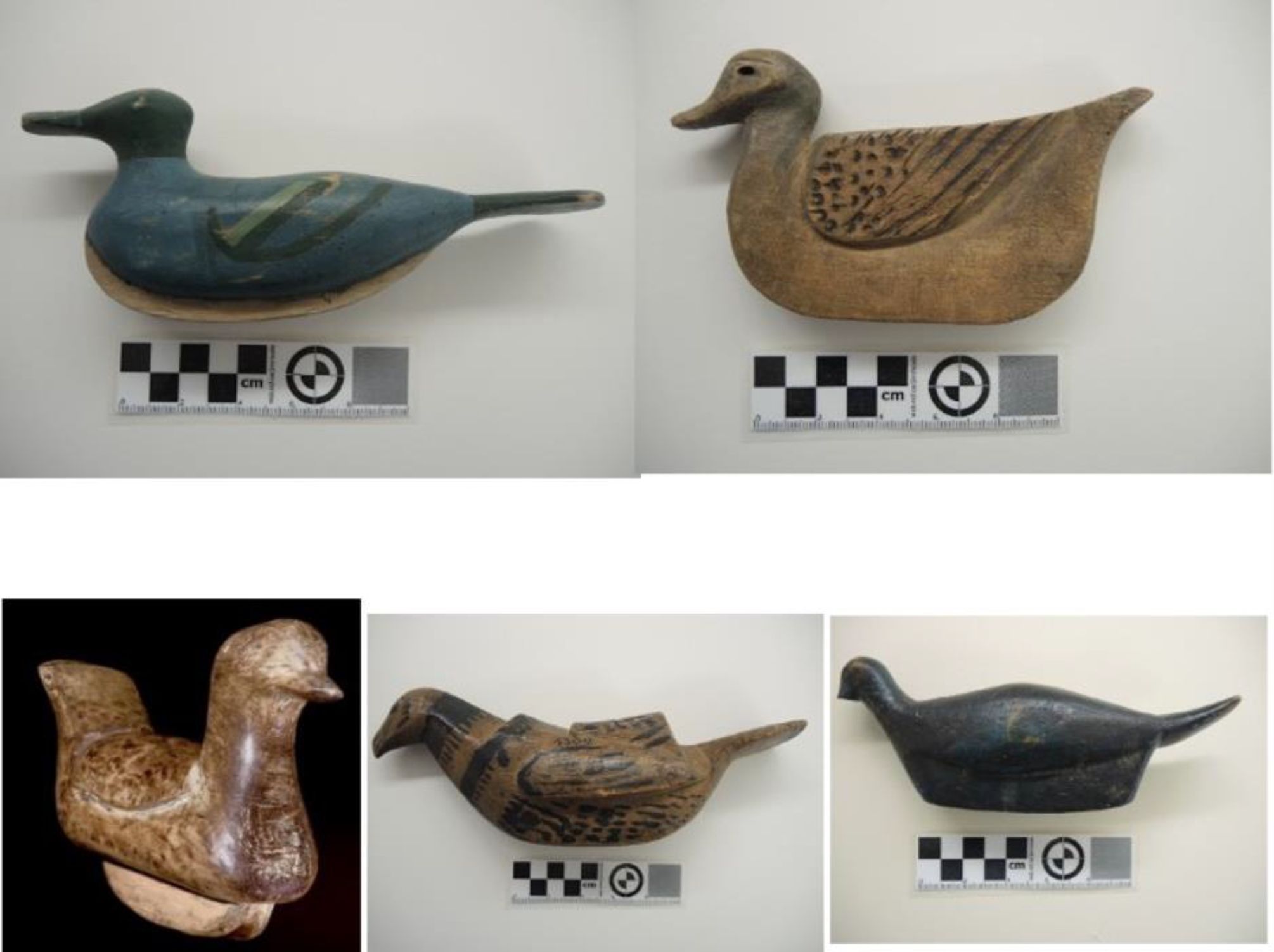
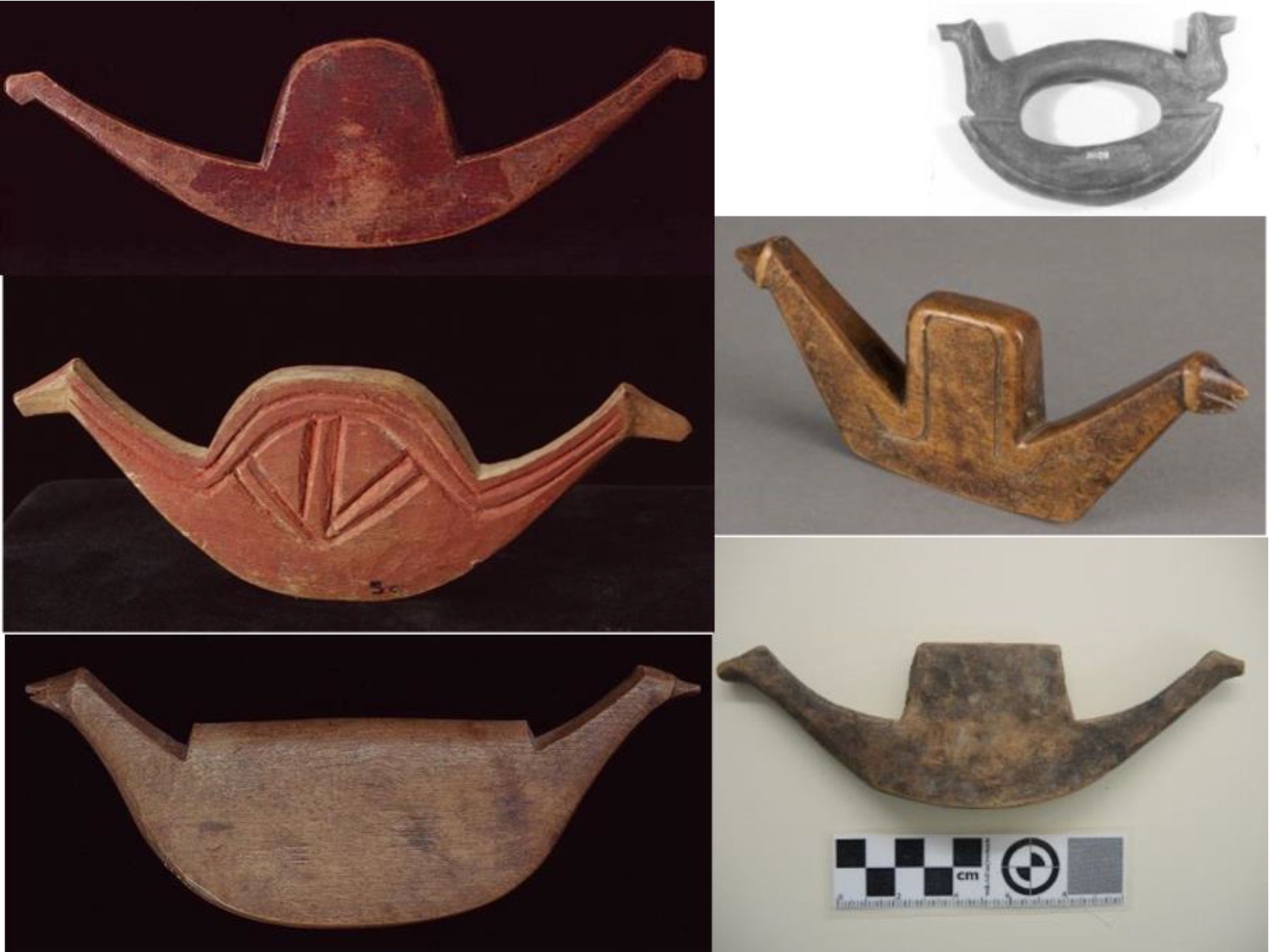
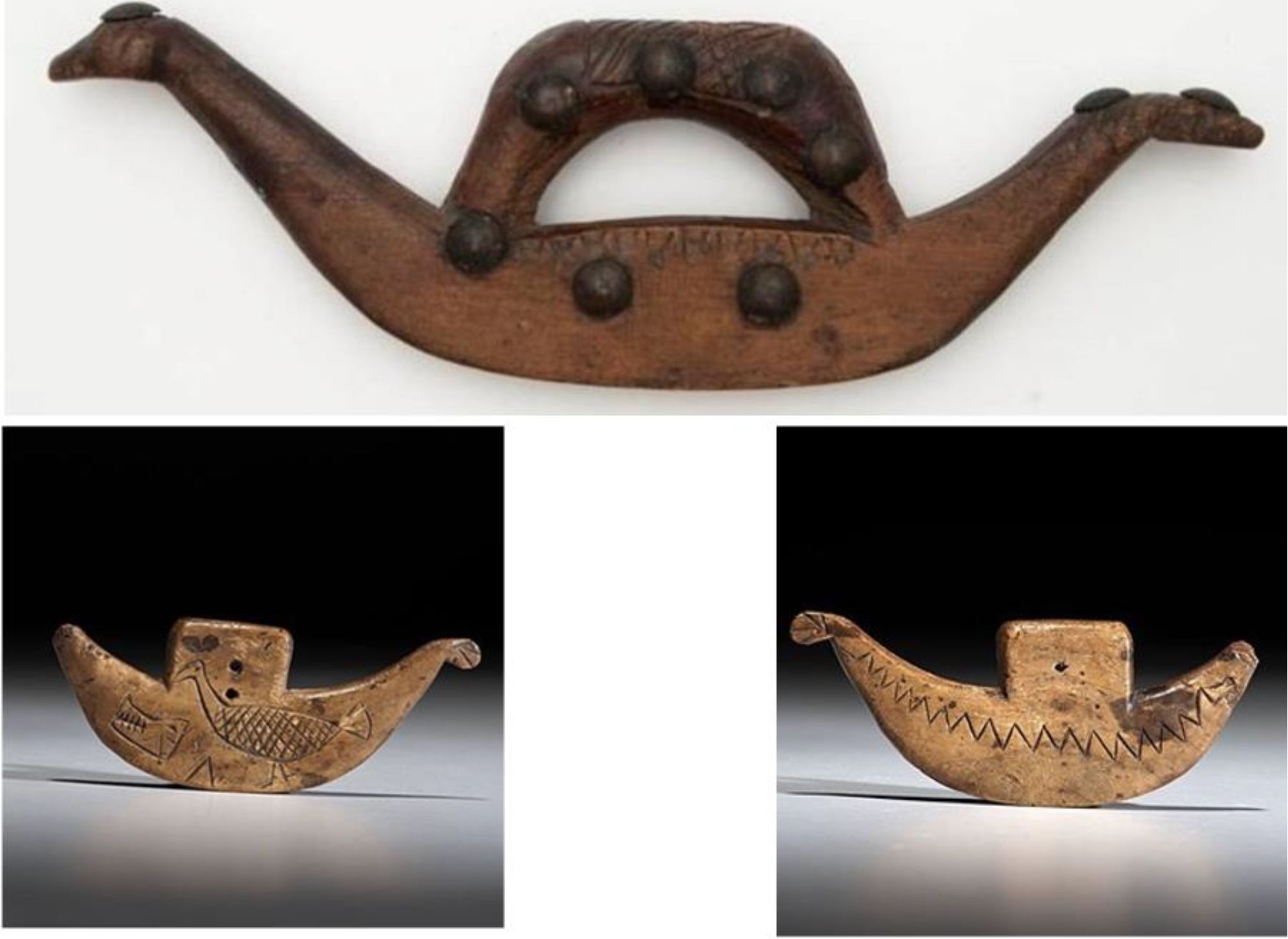
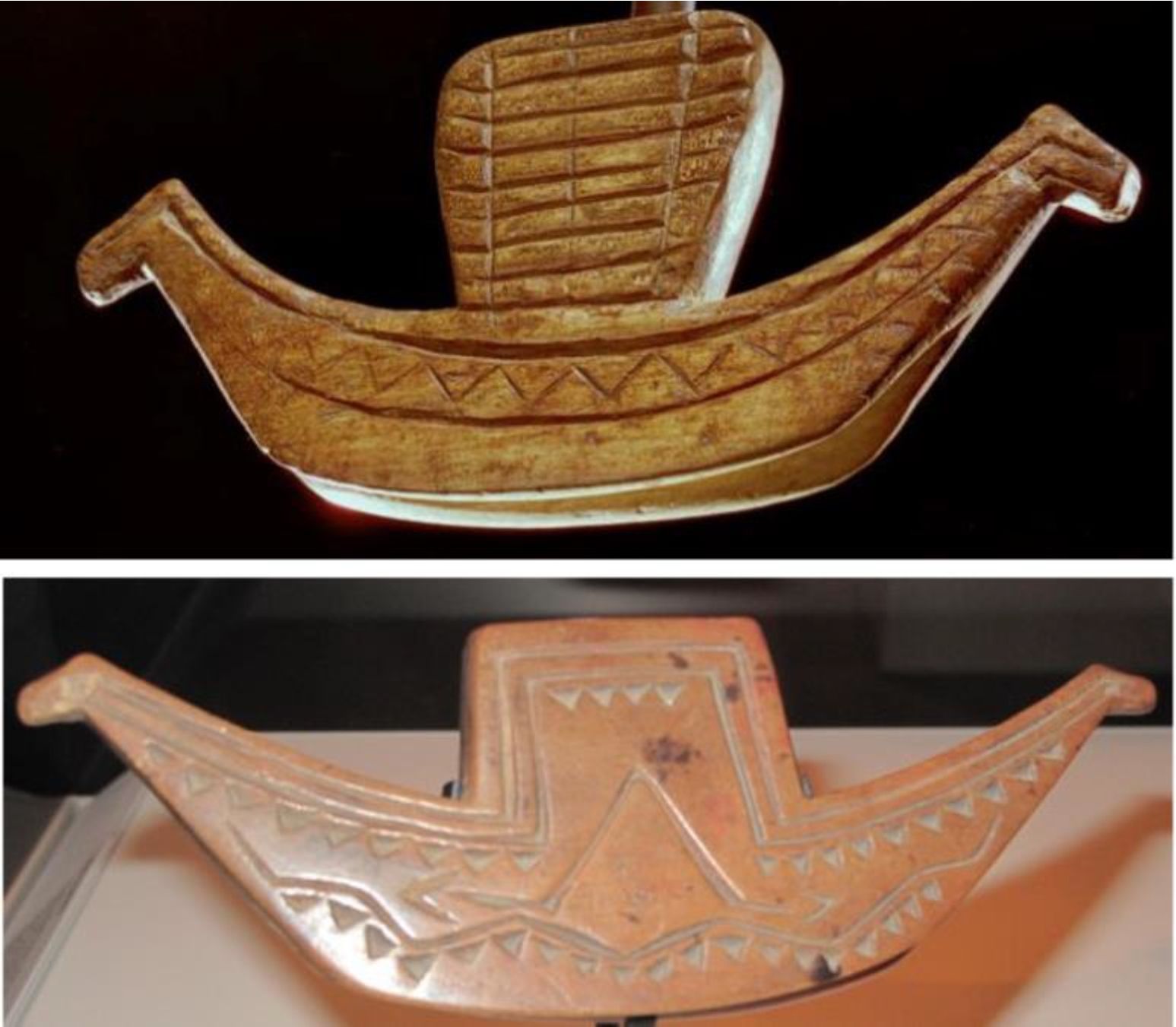
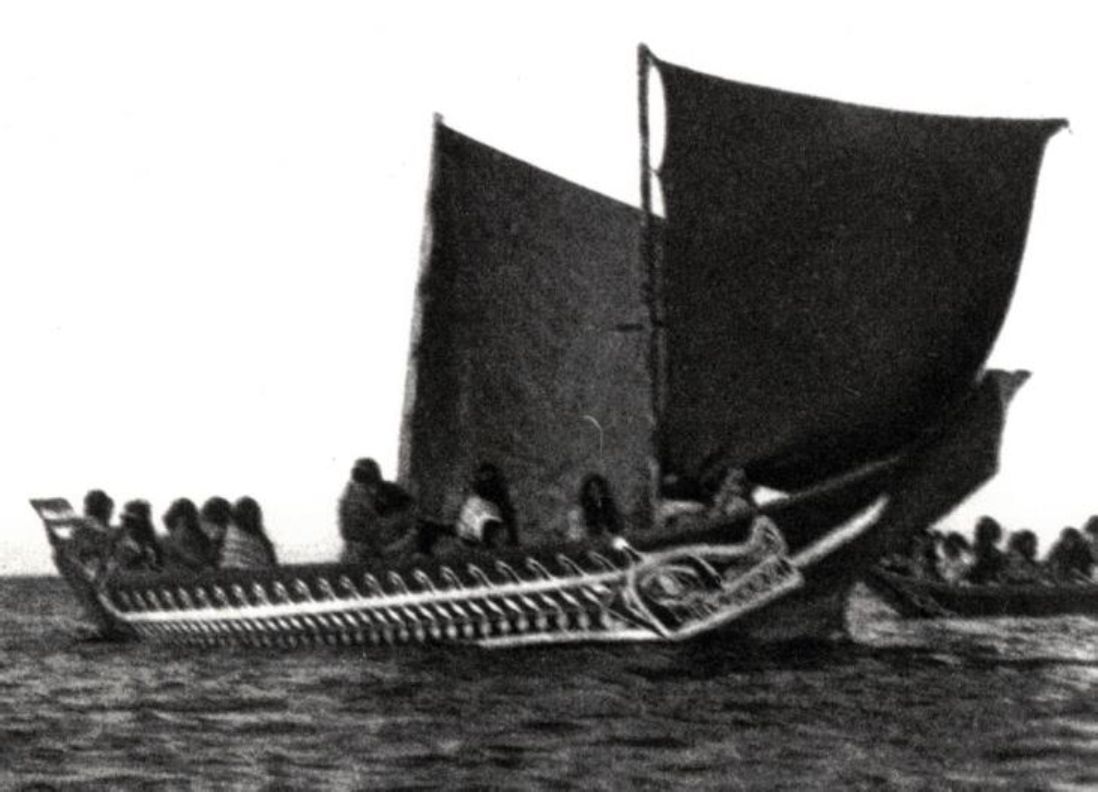
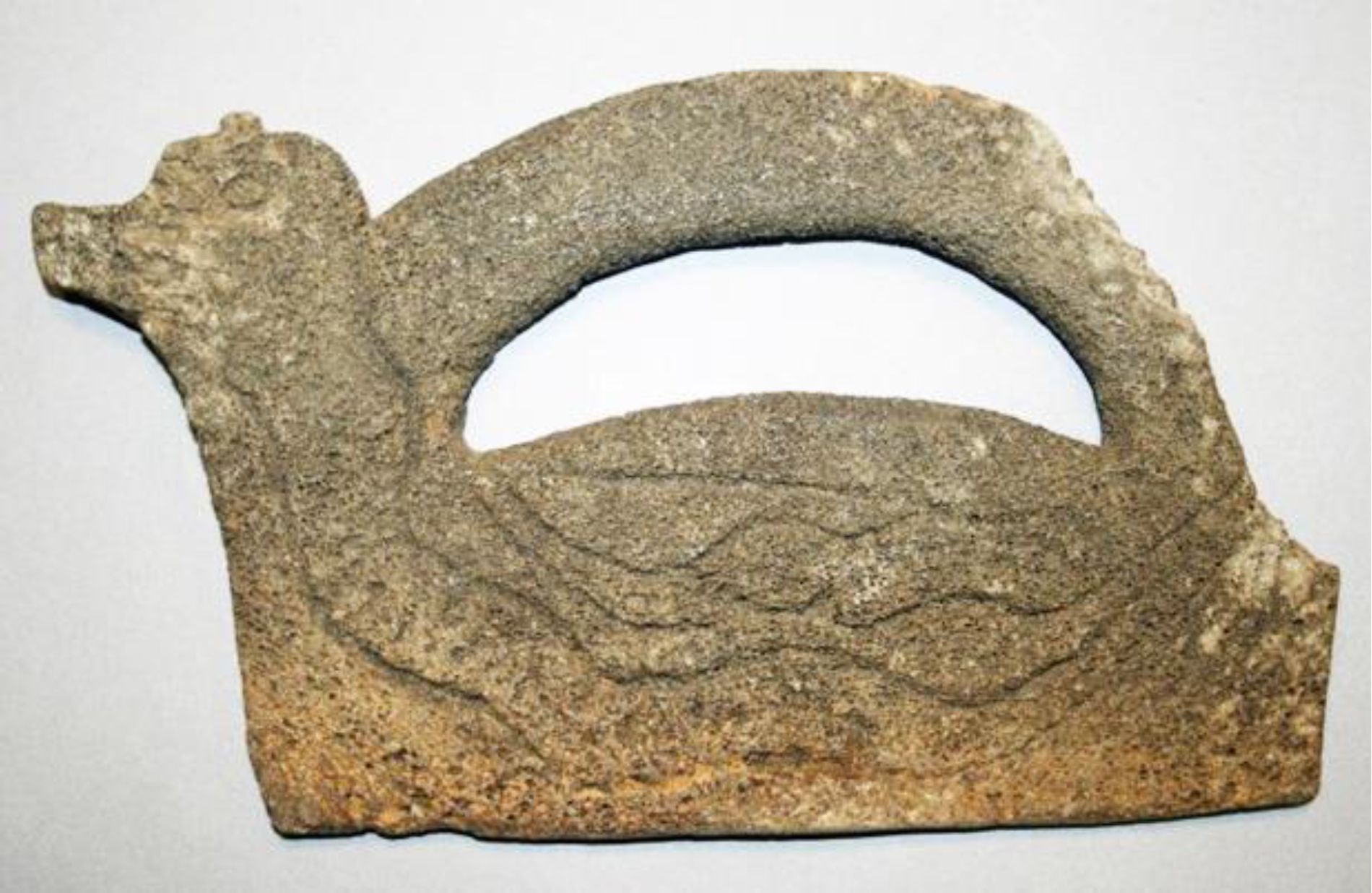
If figure 16 did not have the etching of a snake on the body of the mat creaser, the head part would likely be mis-interpreted as a form of mammal because of its square muzzle. Lightning snakes are often represented on spindle whorls with squarish muzzles. Two of the mat creasers in figure 17 would also be misinterpreted in this way. The upper left example in figure 17 shows the two lightning snake heads being connected by zig zag lines representing their bodies.
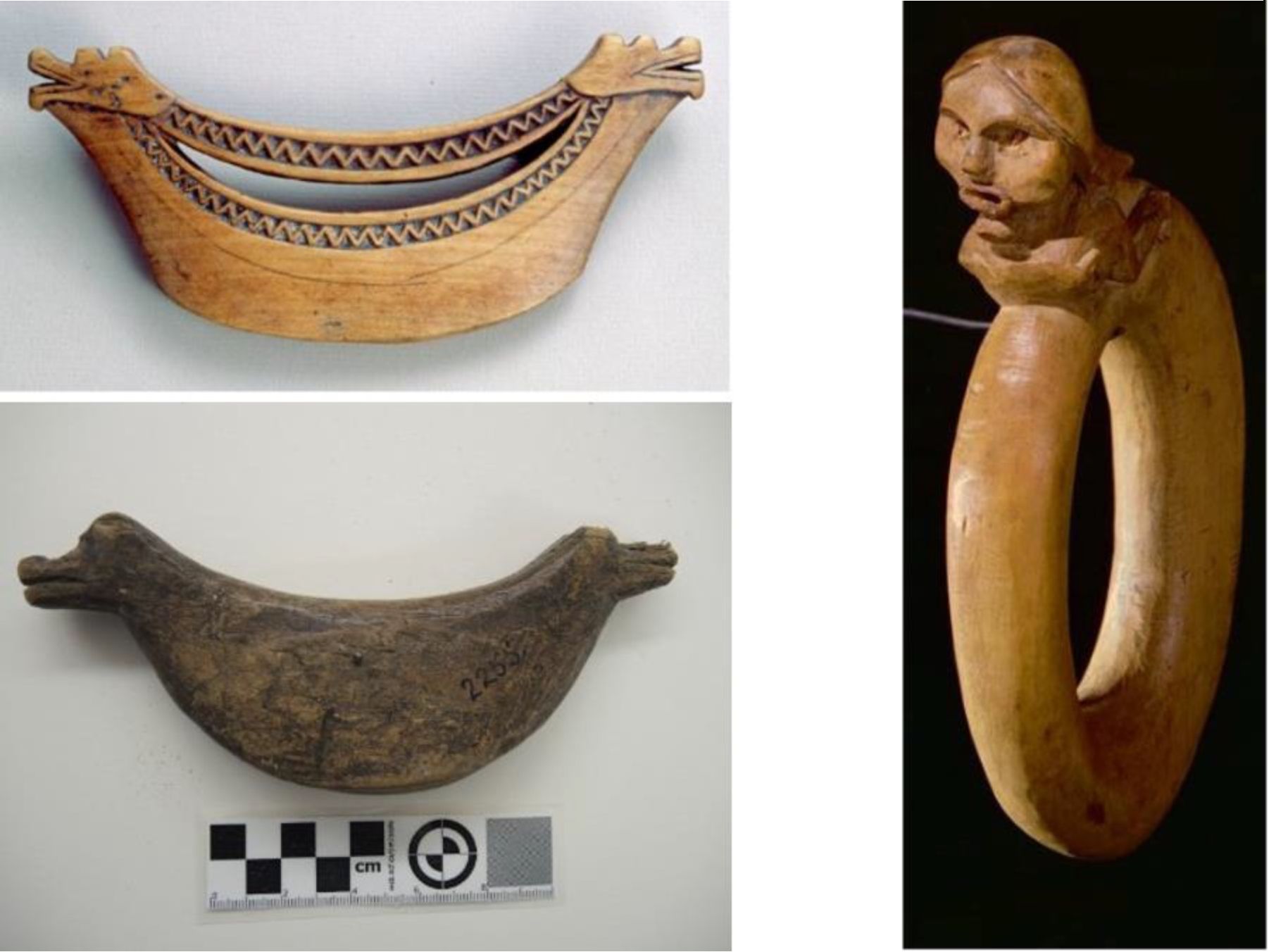
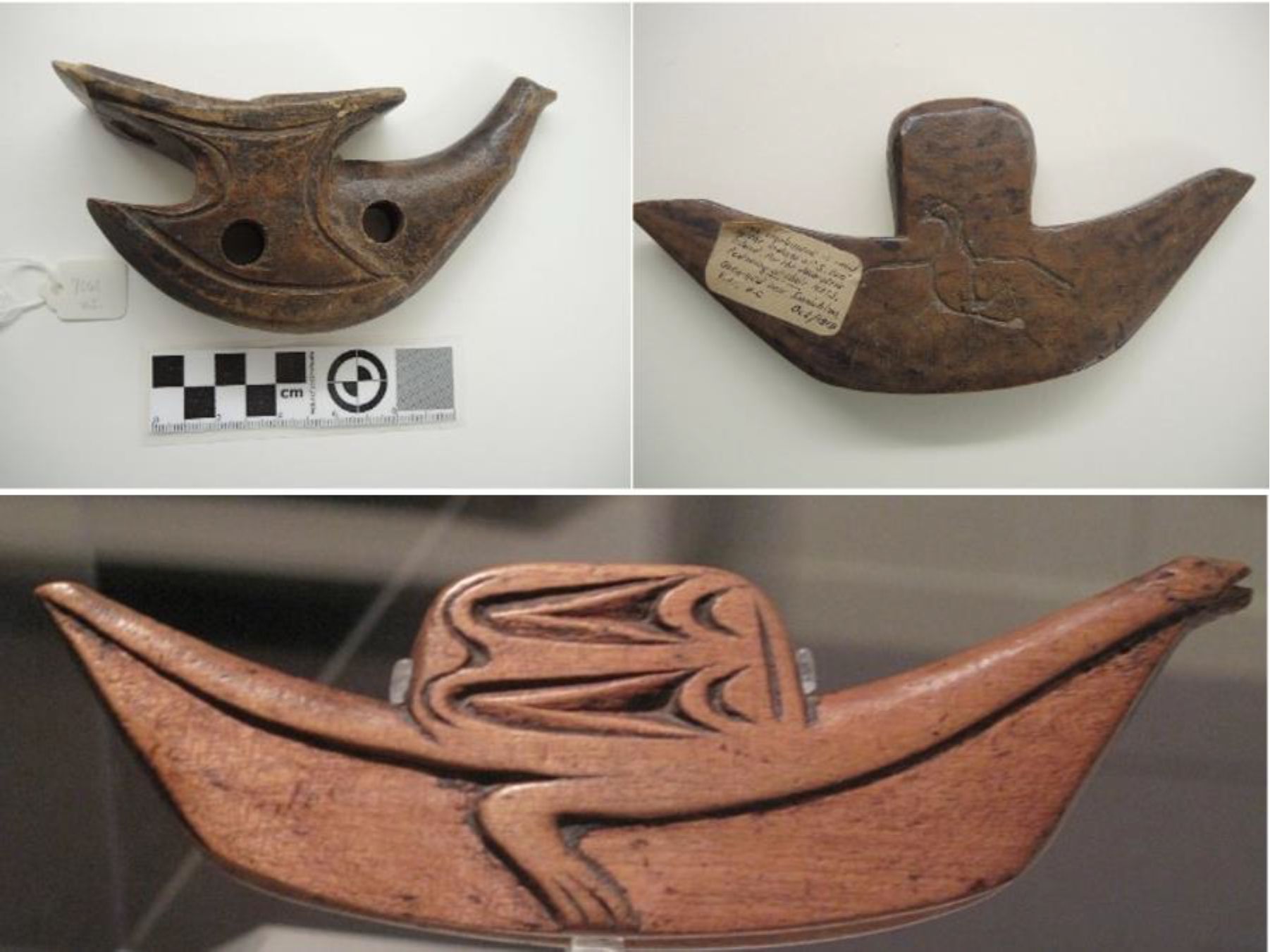
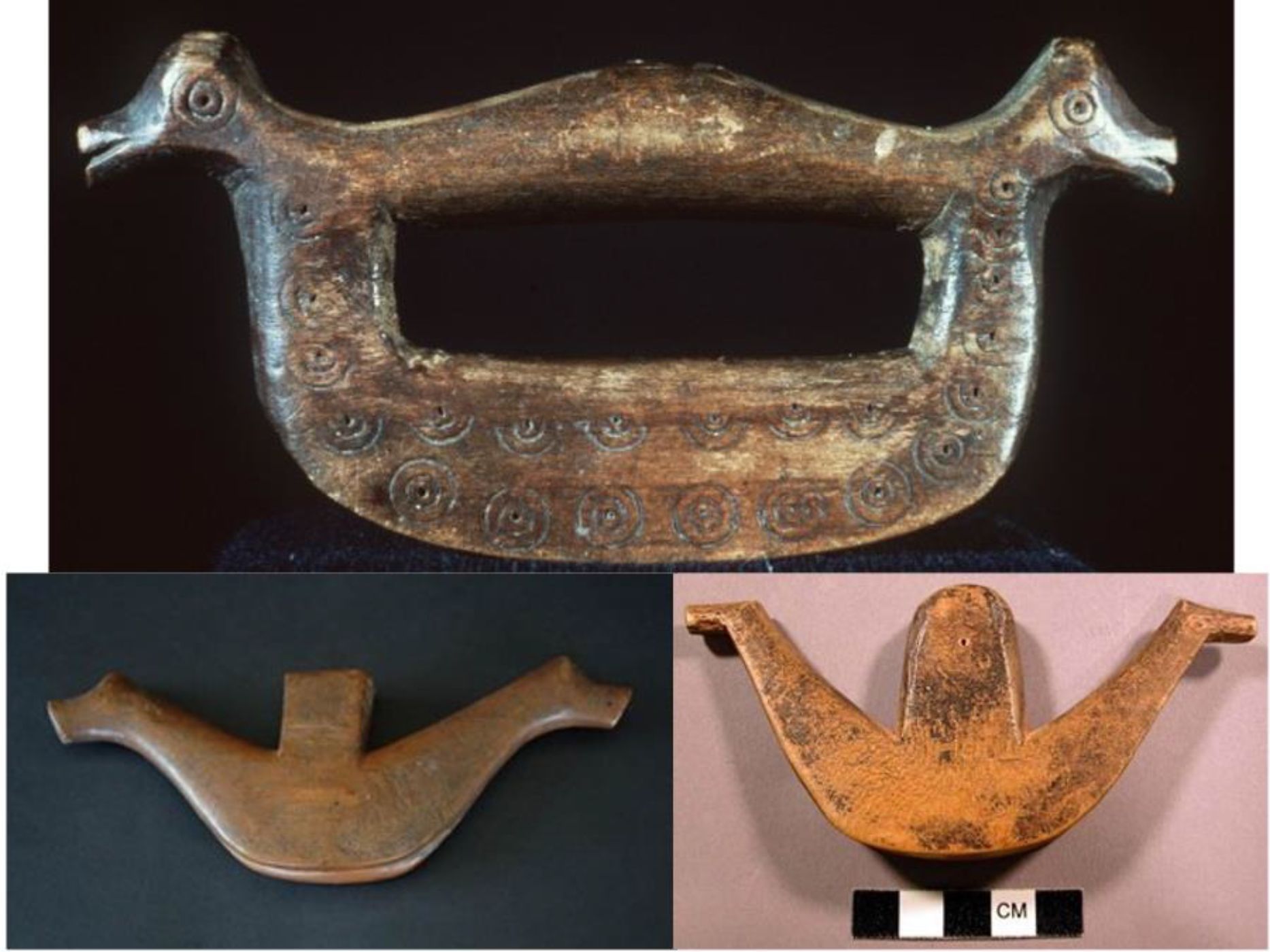
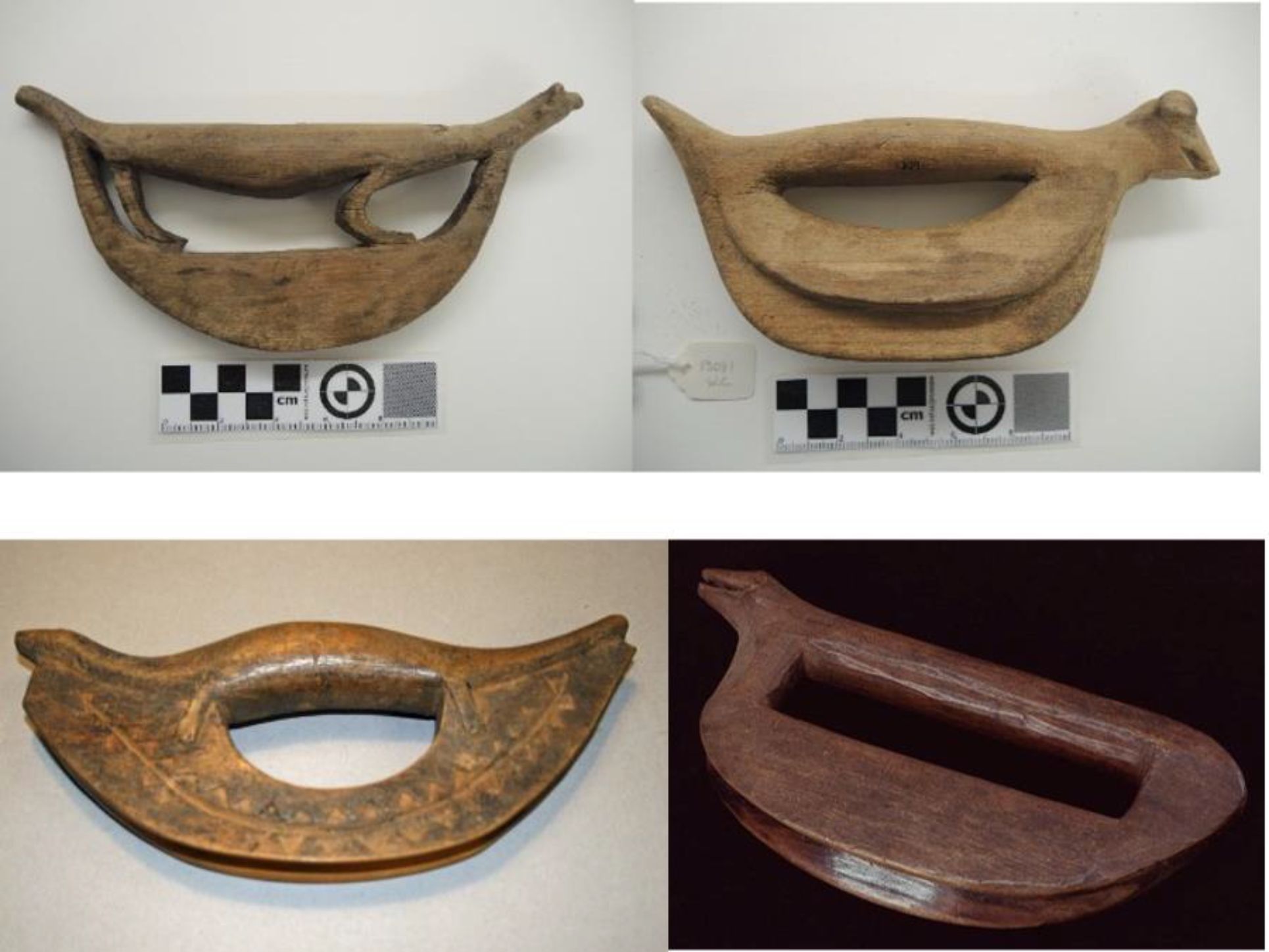
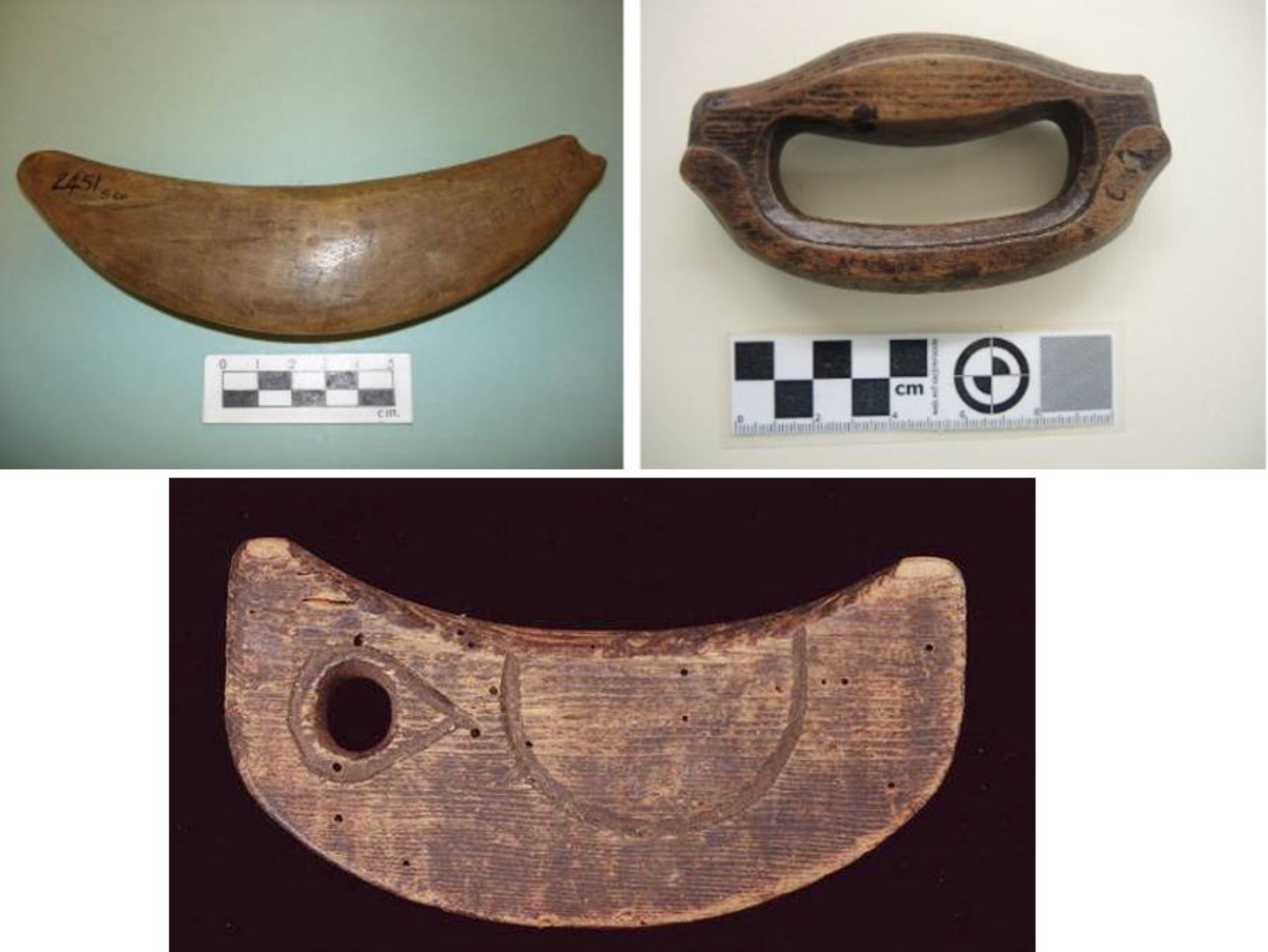
The Ethnographic Record
The best detailed observations of cattail processing were by Myron Elles in the 1880s. Under the title: “Creasing the mat”, he noted that: “Each time the needle was passed through, the woman applied her mat creaser before she removed it”. The creaser was “polished smooth with shark skin and sometimes ornamented. Along its lower edge was a groove which just fitted the ridge of the triangular needle, Holding the mat firm … the woman ran her creaser over the needle, so that a ridge was formed on the mat, just above where the thread ran. This kept the holes made by the needle from being enlarged. In the finished mat, the threads did not show but they were indicated by these rows of parallel ridges. When the mat was sewed, generally with one continuous thread, the woman usually made some sort of finish for the long edges. In rough mats, to be used for camp covering, she might leave them as they were, held together by a row of coarse twinning. For a better finish, she turned the edges of the cattails over for an inch or so and fastened this ‘hem’ with another row of twinning. For really nice mats, like those used on the table, she made the twinning of shiny bear grass, either in the natural yellow or dyed by burying in mud.” (Elles 1887).
Elles describes the matting needles as “of hard wood 3 feet long, half an inch wide, three cornered, and with an eye in one end, in which the string is placed”. He indicates there are seven kinds of mats: “Three are made of cattail rush. The plants are cut by the women in July and August, dried in the sun, and tied in bunches as large as can be comfortably carried. When a woman finds she has time to make mats she assorts her rushes according to size and in three lots. Of the largest rushes she makes the largest mats, about 5 feet wide; of rushes of medium length, she forms mats about 3 feet wide, and of the smaller stalks she weaves mats about two feet wide. All of these may be of any desired length. The largest mats are used chiefly for lining wooden houses and in constructing mat houses. Those of the medium size are used at times for the same purpose. For the half circle camps, for beds, pillows, seats, table covers, and as substitutes for umbrellas and oil cloth, two layers forming an almost complete protection from the rain. The narrowest mats, usually from 3 to 4 feet long, are used mostly for cushions, as in canoes, and for the paddlers to kneel on” … “Some of these are often placed on the ground during feasts and the food placed on them, the guests seated on the ground on each side.” (Elles 1987).
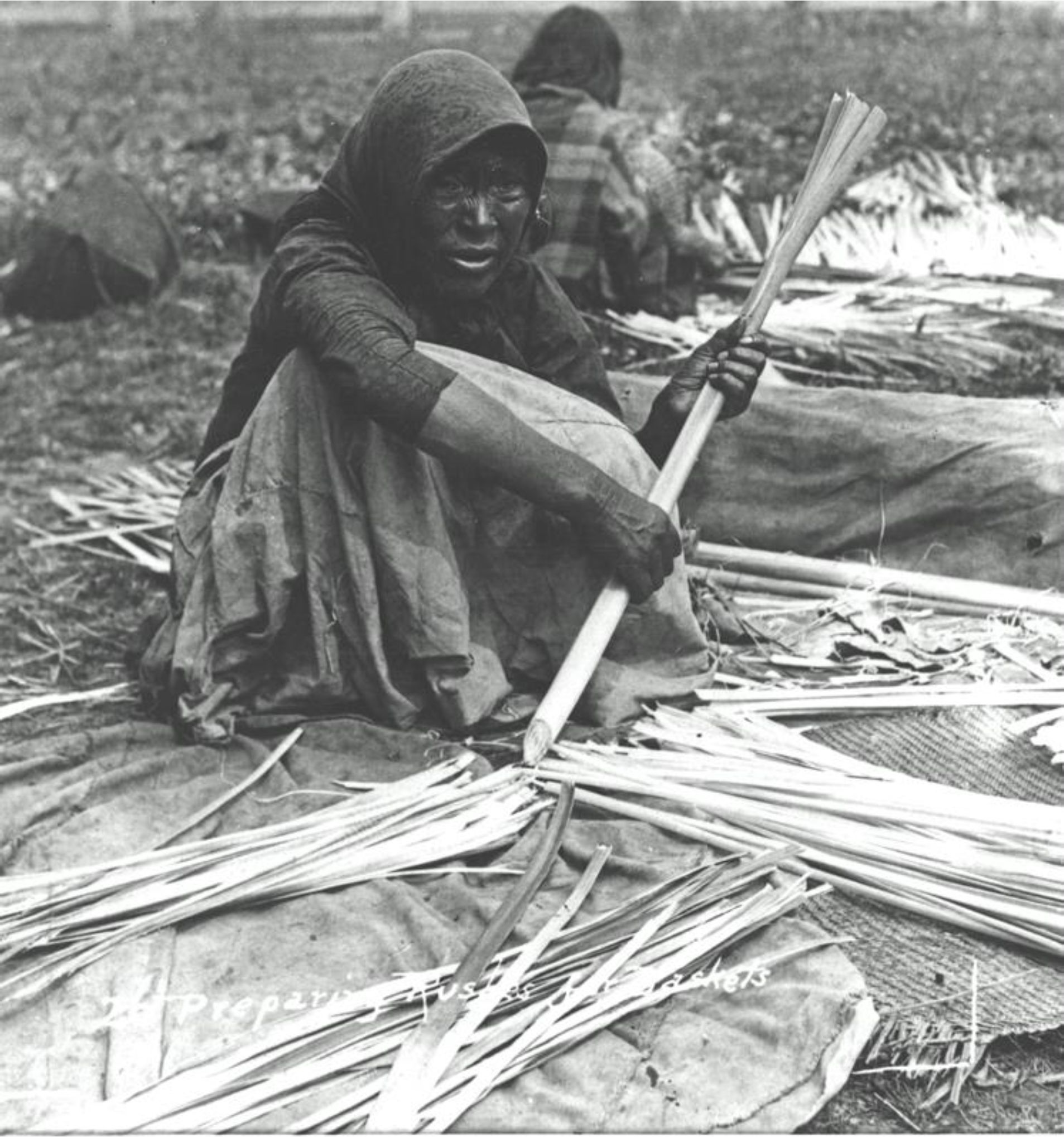
The timing of when various reeds are collected is important. The earliest account of this is provided by Alexander C. Anderson on the collecting of “Bull rush” reeds in his 1834 Milbank Sound Report. He refers to the noncattail family plant now classified as Schoenoplectus acutus (common tule), but I included it here as one of the earliest accounts of reed processing. It is from an area where there was no use of mat creasers.
“These leaves are cut off when full grown and dried in the sun, about the month of June. When the first named rush [Scirpus lacustris] is full grown the women wade out and pull it up, the rush coming up below the point where it emerges from the mud. This has to be done at the critical period, for at no other time will the rush pull up”.
Another early account of the processing of cattail reeds, was written by James Swan based on observations in the early 1850s, regarding the “bulrushes” in Shoalwater Bay, Washington. What is of interest here is Swan’s description of the matting needle as being from the wing bone of a great blue heron.
Swans writes that the “bulrushes”, are cut during the months of July and August, and carefully dried in the sun, and:
“stowed away in some dry place till the fall and winter, when the rains keep them at work within indoors. When the mats are to be made, the head woman of the family sorts out the rushes or flags, and cuts them of the desired length, which is usually three feet. These are then taken, two at a time, placing the top or small end of one with the bottom or large end of the other. These are fastened by a cord twisted round the ends, and the process continued till enough are secured to make a mat of the length required. Those for sleeping on are six or seven feet long. The lining mats may vary with the size of the lodge, and are from ten to twenty, and sometimes thirty feet in length. After each length has been determined on, it is rolled up till wanted for manufacturing.
Each female, whether slave or free, then has her mat assigned to her to make. The rushes are laid down on the lodge floor, or, if the weather is pleasant, are carried out of doors. Two pegs or stakes driven into the ground, one at each end of the mat, and to which the string which bines the ends is made fast, secure the whole. The operator then takes a needle, made from the small bone in the second joint of the wing of the common blue crane, which is straight, long and slender, and which has a hole drilled in one end for an eye, and the other sharpened similar to cutting off a quill when about making a pen. Into this needle is fastened a piece of twine, made of the rushes twisted by hand, and of a length in accordance with the size of the mat. The needle is then passed through every one of the rushes, and the string drawn firm and smooth. A creased bone is then rubbed over the whole length of the twine, which serves to set the work and mark the threads distinctly. The operation is then repeated, the threads being inserted parallel to each other, about four inches apart. When the stitching is done, the whole is bound around with a flat, three-ply braid of rushes, and the mat is finished” (Swan 1857).
Swan’s description is confusing when he states that “A creaser bone is then rubbed over the whole length of the twine, which serves to set the work and mark the threads distinctly”. One could interpret this as saying the creaser is run over the string after the needle is pulled through. Swan likely fails to note that the creaser (“creaser bone”) is run over the edge of the needle while it is in place and then the string is pulled through. From my own experiments with this, the creaser with only the string under the cattail leaves tends to crush rather than kink the cattail stocks and does not leave the string pattern as straight as that done with the needle in place when the creaser is used.
Later descriptions indicate the leaves were sown together using a long wooden needle made from ocean spray branches that were naturally long and strait and using twined stinging nettle as a thread. None of the smaller bird bone needles specifically noted by Swan as being used in mat making are found in, or not identified in, Museum collections.

The biologist John Keast Lord made observations on the processing of “tule” reeds on the lower Fraser River in the 1860s: “The Sumass [Sema:th] and Chilukweyuk [Ts’elxweyeqw] Indians frequently use rush mats; the rushes are harvested, and brought from long distances, then carefully dried in the sun; when dried they are sewn together with long needles made of hard wood varying in length from six feet to four inches, threaded with cord twisted from the smaller rushes; mats thus made are perfectly rain-proof “ (Lord 1866).
It is interesting that Lord’s account indicates that the wooden matting needles have a lower range of “four inches”. This corresponds in size to Swan’s observation of the needle being the wing bone of a great blue heron.
Susan Johnson of the Sooke Nation, born in 1910, provided some important detailed information on the tying of the mats:
“At each end of the mat a woven strip of braid of cattails is some times sewn on parallel to the leaves before starting back on the bottom layer. The other edges are sometimes finished with leaves of bear grass (xerophyllum tenax). This made them strong and fray-resistant.” (Johannesson 1984).
Discussion
The earlier examples of mat creasers found in Museum Collections around the world, from the region under discussion, show more detail of design and expression of the subject mater of the design than later examples. These changes are likely the result of the enormous social disruption brought about by the activities in the late pre-contact and early contact period.
The geographic distribution of Indigenous peoples was affected by the 1780 smallpox event, raids and warfare that went on before European settlement, the early post settlement movement of people from the Gulf Islands to Vancouver Island and the Mainland and the 1862 smallpox epidemic.
Trade relations between on the Olympic Peninsula and the south end of Vancouver Island and Nuu-chan-numth peoples on the west coast of
Vancouver Island by late pre-contact time (Wagner 1933) would have affected the more symbolic aspects of artifact design.
Both the Nuu-chan-nulth and Salish language speakers had similar traditions of lightning snakes with various shapes and attributes. The common, less detailed, form of the double headed lightning snake on mat creasers appears to have been a product of later historic exchange where the knowledge and privileges of the makers of mat creasers was being altered by cultural change. Or, simply less effort was being put into artistry of exported mat creasers that would not have the same social prerogatives in the cultures that received them.
Cattail mats were traded to the Nuu-chan-nulth, but the fact that they have mat creasers and matting needles implies that they were making mats. They may have been trading for large amounts of the prepared bundles (figure 6) and processing them into the finished product.
Anthropologist Erna Gunther noted: “The Nisqually are supposed to have made cedar bark as well as rush mats. If this information is correct, they are the only Puget Sound tribes that made them. The rush is far more common among the Klallam and the tribes about the Sound and southward. Here again the process of making them is practically the same throughout the area of their distribution, which stretches along the coast southward to California and inland through the Great Basin” (Gunther 1927:225).
Here we get into the problem of what is included in the word “rush”. It should be mentioned that a simpler but less efficient reed mat was also made by inter-lacing and tying the individual reeds that did not involve piercing them or the use of a mat creaser. The distribution of mat creasers is limited within the large region mentioned here.
Ethnobotanist Nancy Turner notes, that elders suggested that the use of Cattail mats is a more recent practice that spread from Salish family speakers to the Nuu-chan-nulth and Kwakwakwakwa peoples (Turner 1998).
Suttles indicates that in early post contact times two secret Societies from the West coast of Vancouver Island have infiltrated into Salish Speaking populations. Some of the similar beliefs around thunderbirds and lightning snakes may be an earlier manifestation of cultural influences (Keddie 2023).
There is a suggestion that some of the southern Nuu-chan-nulth once spoke a Salish family language and the blending of cultures was already underway before the contact period. The movement of Nuu-chan-nulth peoples to the Northwestern portions of the Olympic peninsula and some moving back to Vancouver Island is still a question awaiting further investigation.
There is a suggestion of earlier cultural influences going back 1000 years between Nuu-chan-nulth cultures with the presence of similar stone fish hook shanks occurring primarily on the southern tip of the Island among Salish language speakers (Keddie 2005). It is possible that the similarity in mythology and the icons on material objects is a result of cultures to the south, west and north of the Salish Sea region filtering into each other, at least intermittently over a long period of time.
Appendix I. The Hoko River Artifact.
A well-preserved wooden artifact (figure 24), depicting two birds believed to be kingfishers, was found at the Hoko River site Hoko 45-CA-213. It was found below layers dating to 2750 B.P., and described as “forming the handle of a weaving tool called a ‘matcreaser’ ” (Croes 1988).
The grooved base of all historic creasers is V-shape in order to crimp the cattail reeds over the thin edge of the mat needle below. The Hoko River artifact has a very rounded base groove and simply cannot do a proper job of crimping. I experimented with an exact replica of the artifact and could not make it work. Figure 25, shows a rounded stick in a rounded hole and shows how the round shape prevents it from fitting over the normal thickness size range of mat needles. Running the Hoko artifact over the string after the needle was pulled out resulted in crushing rather than kinking the cattail leaves and making it difficult to keep the string in a straight line.
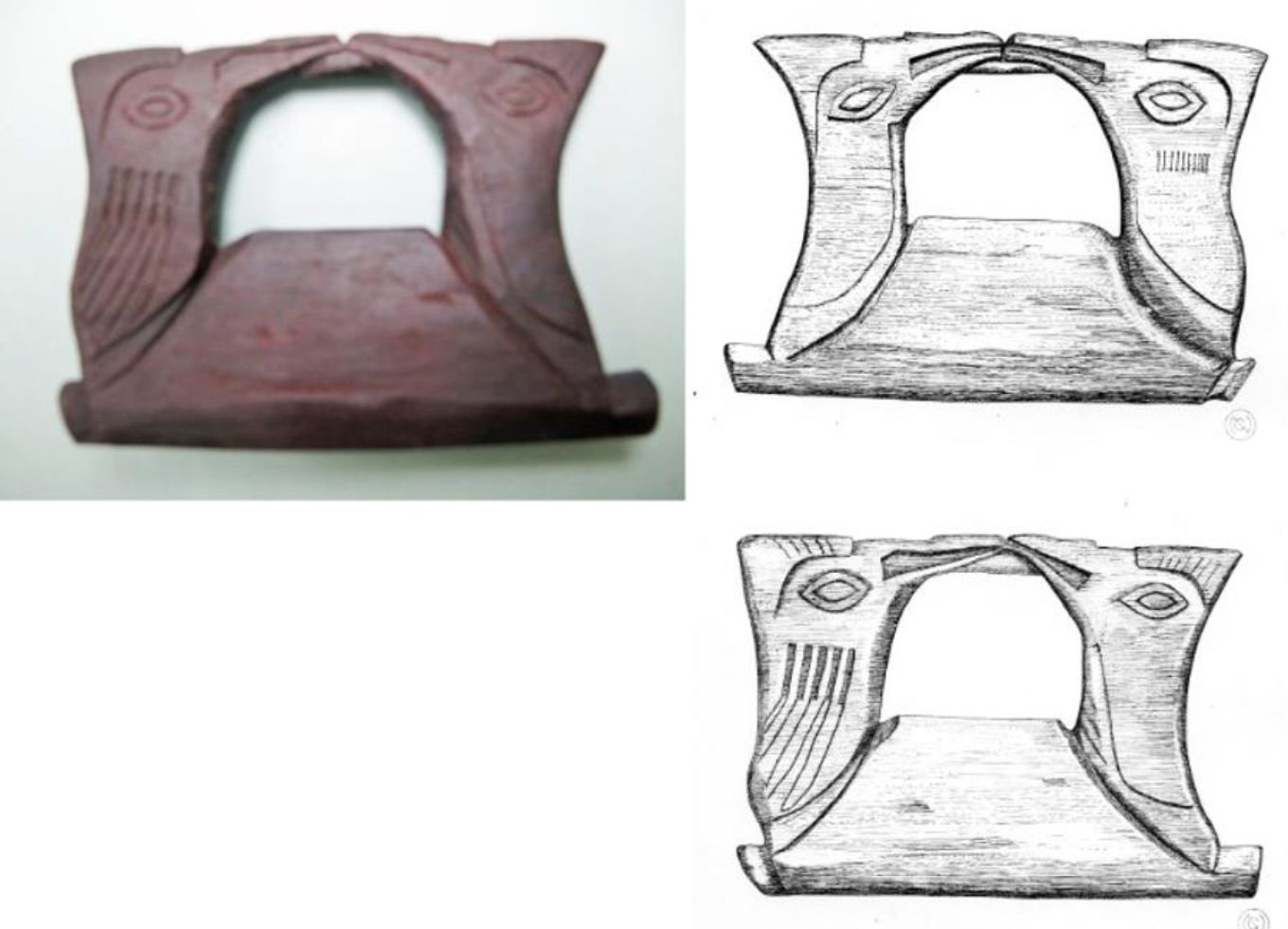
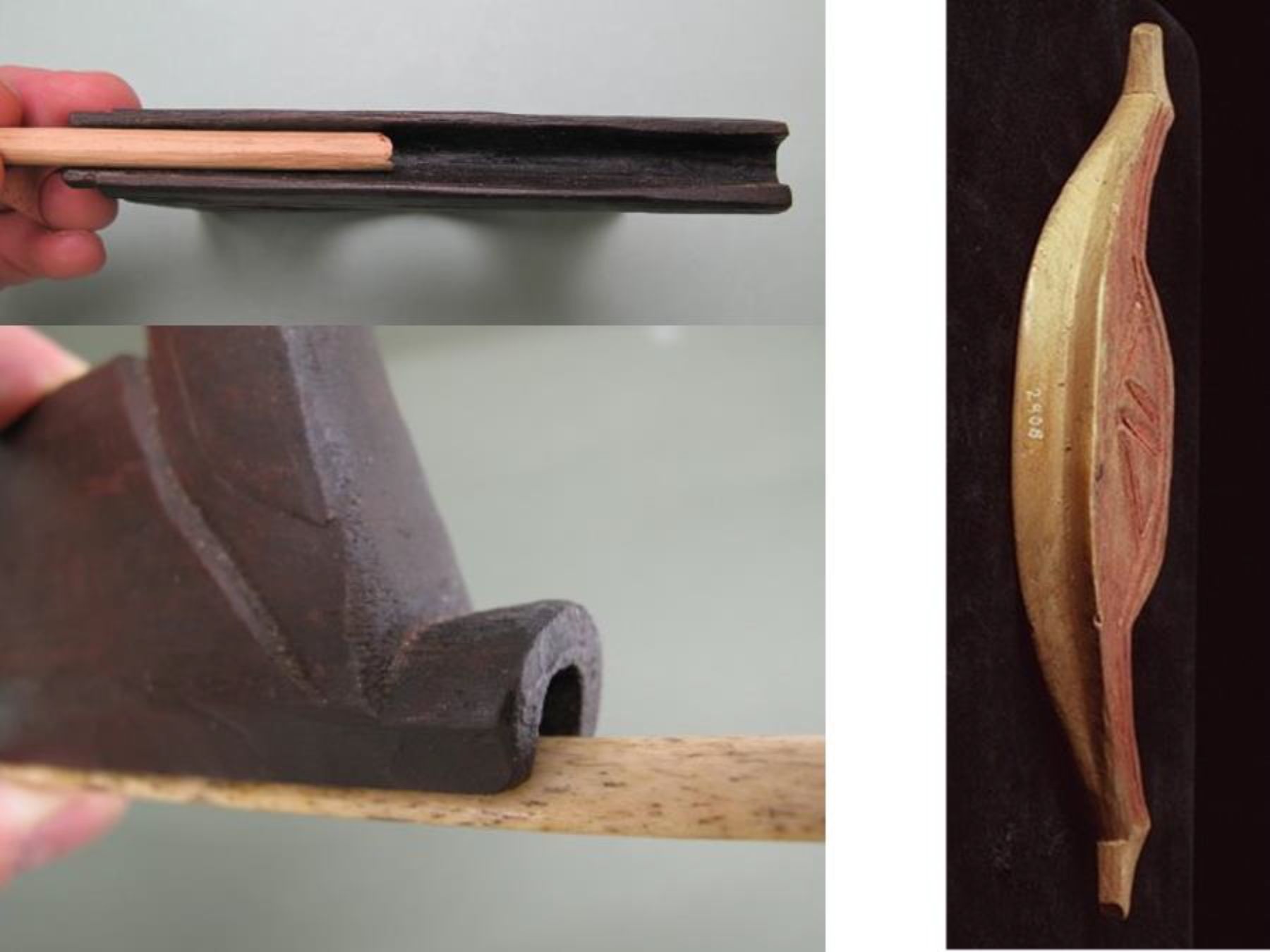
References
Anderson, Alexander C. 1834. The Milbank Sound Report. RBCM Archives.
Croes, Dale. 1988. The Significance of the 3000 B.P. Hoko River Waterlogged Fishing Camp in Our Overall Understanding of Southern Northwest Coast Cultural Evolution. Pp. 131 – 152. IN: Barbara Purdy. (ed) Wet Site Archaeology. The Telford Press New Jersey.
Ells, Myron. 1887. The Twana, Chemakum and Klallam Indians of Washington Territory. Report of the Smithsonian Institution, 1886-1887, pp. 604-681.
Gunther, Erma. 1927. Klallam Ethnography. University of Washington Publications in Anthropology 1.
Gunther, Erma. 1945. Ethnobotany of Western Washington. University of Washington Publications in Anthropology 10:1:1-62. University of Washington Press.
Johannesson, Kathy. 1984. Making Cattail Mats. In: Utility Basketry of the Nortwest Indians. IV(3)15:18-19.
Johannesson, Kathy. 1984. Utility Basketry of the Northwest Indians. In: Utility Basketry of the Northwest Indians. IV(3)15:13-17.
Keddie, Grant. 2005. Fish Hook Shanks in the Collection of the RBCM from Southern Vancouver Island.
Keddie, Grant. 2006. The Early Introduction of Iron Among the First Nations of British Columbia. Royal B.C. Museum Web Site.
Keddie, Grant. 2023. Spindle Whorls in British Columbia Part 4. Thunderbird and Lightening Snake Iconography. Grantkeddie.com web site.
Lane, Barbara. 1972. Makah Economy Circa 1855 and the Makah Treaty. A Cultural Analysis. Submitted as a court Document to the Washington State Indian Claims Commission on Dec. 15, 1972.
Lord, John Keast. 1866. The Naturalist in Vancouver Island and British Columbia. Vol. 2. Richard Bentley, New Burlington Street. Publishers in Ordinary to her Majesty, London.
Swan James G. 1857. The Northwest Coast. Reprinted by Ye Galleon Press. 1989, with an introduction by W.A. Katz.
Turner, Nancy J. 1998. Plant Technology of First Peoples in British Columbia. Royal B.C. Museum Handbook. U.B.C. Press, Vancouver.
Wagner, Henry. 1933. Spanish Explorations in the Strait of Jan de Fuca. Santa Ana California.
